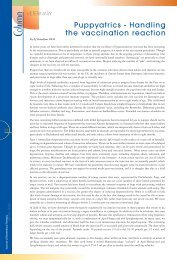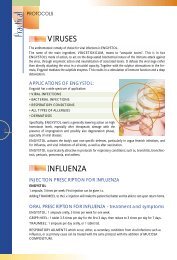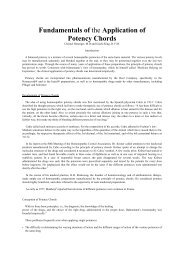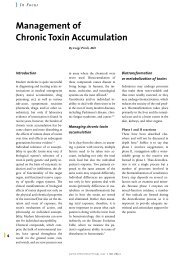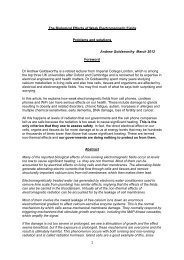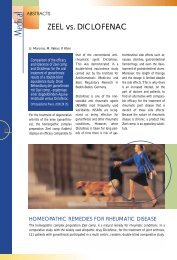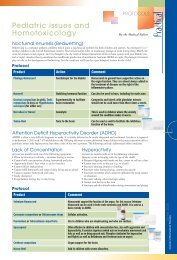Tip - Bio Pathica Ltd
Tip - Bio Pathica Ltd
Tip - Bio Pathica Ltd
You also want an ePaper? Increase the reach of your titles
YUMPU automatically turns print PDFs into web optimized ePapers that Google loves.
6<br />
Practical<br />
PROTOCOLS<br />
These are mild protocols with infrequent dosing. The younger the patient, the softer the therapy should be,<br />
which means that frequent administration is not necessary. In fact, the above protocol can be given on an<br />
“as needed basis,” or the physician can adjust the frequency of administration to the baby’s needs and to the<br />
mother’s constitution. For infants, the drinkable saline-based ampules are favored over the alcohol-containing<br />
drops.<br />
<strong>Tip</strong>:<br />
Apply remedies directly to the mucous membranes with any plastic pipette.<br />
Remedies can also be placed directly in the bottle of the formula. Add the remedies just before serving the<br />
baby’s formula and discard leftover formula. Always give remedies in a fresh batch of formula.<br />
The main remedy here for infants is VIBURCOL. Overall, this remedy applies to agitation, and we know<br />
agitation in newborns comes from physical discomfort of conditions like colic, fever, or distress of some<br />
kind, whether emotional or environmental.<br />
Available as suppositories or saline-based monodoses*, VIBURCOL is a must to have in your pediatric kit.<br />
Its unique formula combining Chamomilla, Belladonna, Dulcamara, Plantago, Pulsatilla, and Calcarea<br />
carbonica is the perfect combination for agitation due to otitis, colic, teething, or insomnia, and the accompanying<br />
fever associated with most of these conditions.<br />
VIBURCOL: the recommended dosage for the suppositories: one suppository daily is usually sufficient<br />
for an infant, as the remedy is delivered in a fragmented way through the suppository.<br />
During fever for example, the suppository can be introduced once during a<br />
18-hour period. Otherwise, for treatment purposes, one suppository 3 times a week. The<br />
duration of the protocol will depend on the condition, but can continue for 1 to 3 weeks.<br />
WHEN COLIC OCCURS IN TRANSIT<br />
When colic only occurs in transit, then it is most likely that your baby is “car sick.” COCCULUS-<br />
HOMACCORD can remedy this situation in most cases.<br />
CAR SICKNESS<br />
1 drop of COCCULUS-HOMACCORD (ampule) 15 minutes to a half hour before leaving. During long<br />
trips one drop can be repeated every hour or two. No more than 6 or 7 drops should be given to an infant<br />
per day.<br />
An alternative way to administer a car sickness remedy is to put 2 drops of COCCULUS-HOMACCORD<br />
in 125 ml of baby formula and use this formula ad lib on the trip. Unused formula should be discarded after<br />
4-6 hours.<br />
OTITIS<br />
Alternatively: The monodoses* can be given on an as-needed basis (follow age-related<br />
dosage on the packaging). The monodoses hold a half milliliter of solution<br />
that can be easily squeezed onto the baby’s tongue. You can also instruct<br />
parents to squeeze a drop or two onto their finger and introduce it to the<br />
inside of the baby’s cheek. For acute conditions, the latter method can be<br />
applied every 15 minutes to half an hour until the baby is comfortable.<br />
* Not available in all countries<br />
TRAUMEEL quickly relieves the pain and heat from otitis. Traumeel eardrops/Oteel/BHI Pure Eardrops*<br />
are easy to administer; just squeeze half the contents of the doser into each ear. Otherwise Traumeel ampules<br />
may be used (1-2 drops per ear).<br />
It is recommended to give VIBURCOL suppositories or monodoses* at the same time to quell the fever and<br />
agitation associated with otitis. Often warning symptoms occur a day or so before onset of otitis, in the form<br />
of hot flushed face and agitation. VIBURCOL can be given at the first sign of these symptoms.<br />
FOR EXTRA SOOTHING: Traumeel ointment can be applied to the base of the infant’s ear to provide<br />
direct pain-killing action, and a soothing anti-inflammatory film. Apply a thin layer of ointment every half<br />
hour during the acute phase.<br />
*Not available in all countries<br />
HOMEOPATHIC THERAPY OF<br />
GYNECOLOGICAL DISORDERS<br />
Dr. Valérie Reus, Michael Weiser • Reprinted from <strong>Bio</strong>logische Medizin • Vol. 28, No. 5, 1999, pp. 233-236<br />
ABSTRACT<br />
ABSTRACTS<br />
This multicentric prospective study systematically investigated usage indications, dosages, therapeutic efficacy, and tolerance<br />
of Hormeel S (drops). A total of 345 cases of treatment were documented by 41 physicians. The most frequent reasons for<br />
prescribing Hormeel S were premenstrual syndrome and menopausal symptoms. Hormeel S was reliably effective and well<br />
tolerated not only in combination with other forms of therapy but also when used alone.<br />
INTRODUCTION<br />
Keywords: Hormeel S, menopausal symptoms, premenstrual syndrome.<br />
Hormonal dysfunctions are among the most frequent ailments<br />
of women of reproductive age. Premenstrual syndrome<br />
is most prominent in women in their twenties or<br />
older, while dysmenorrhea is observed primarily in very<br />
young women 4) . Delayed or skipped ovulation due to hormonal<br />
disturbances is also one of the most frequent causes of<br />
infertility in couples who have been attempting to conceive<br />
for years 7) . The menstrual cycle, however, is not exclusively<br />
hormonally regulated but is also linked to complex CNS<br />
functions. Therefore, menstrual disorders can also be either<br />
triggered or masked by psychological factors 9) .<br />
Because of the possibility of undesirable side effects, hormone<br />
substitution is not always the optimal solution to such<br />
problems 1) . Thus many women today are refusing hormone<br />
treatment and looking for therapeutic alternatives that are<br />
both better tolerated and convincingly effective. In comparison<br />
to hormone substitution therapy, both phytotherapy 1),11)<br />
and homeopathic remedies 2) have proved quite effective in<br />
treating functional menstrual disorders and female infertility.<br />
Gerhard et al. demonstrated the success of both individually<br />
selected homeopathic single remedies and homeopathic<br />
combination remedies (such as Hormeel S) in treating hormonal<br />
dysfunctions and fertility disorders 6),8) . The advantages<br />
of homeopathic therapy over hormone substitution include<br />
better tolerance and the absence of multiple pregnancies or<br />
ovarian cyst formation 6),8) .<br />
As is to be expected from the drug pictures of its components<br />
(Table 1), the homeopathic combination remedy Hormeel S<br />
(manufactured by <strong>Bio</strong>logische Heilmittel Heel GmbH,<br />
Baden-Baden/Germany) has been used successfully for more<br />
than thirty years in treating hormonal dysfunctions (especially<br />
disorders of the menstrual cycle and related symptoms<br />
such as painful menstruation and menopausal complaints)<br />
and as an adjuvant therapy in female infertility. Although<br />
Hormeel S is commercially available in two forms - drops<br />
and injectable solution - only the oral form was considered in<br />
this prospective study, whose purpose was to gather information<br />
on the usage indications, dosages, efficacy, and tolerance<br />
of Hormeel S.<br />
INGREDIENT DRUG PICTURES / INDICATIONS OF INGREDIENTS<br />
Acidum nitricum D4 (nitric acid) Inflammation of the skin and mucous membranes, (including urethra<br />
and vulva); skin tends to crack. Ulcerations. Benign and malignant<br />
growths. Diseases involving weight loss. Depressive moods.<br />
Aquilegia vulgaris D4 (columbine) Sleep disorders with nervousness. Also dysmenorrhea, functional<br />
amenorrhea.<br />
Calcium carbonicum Hahnemanni D8 Disorders of calcium metabolism. Chronic diseases of the mucous<br />
(inner white portion of oyster shell) membranes. Proliferative processes of the mucous membranes.<br />
Cyclamen D4 (alpine violet) Headaches. Menstrual disorders. Depressive moods.<br />
Cypripedium pubescens D8 (lady-slipper) Sleeplessness (especially in over-stressed women).<br />
Erigeron canadensis D3 (fleabane) Uterine hemorrhage (menorrhagia, metrorrhagia).<br />
Ignatia D6 (St. Ignatius’s bean) Nervous disorders. Depressive moods. Cramps in the hollow organs<br />
and muscles.<br />
Majorana D4 (marjoram) Heightened sexual arousal and nervous irritability.<br />
Moschus D6 (glandular secretion from Nervous disorders such as excitability and fainting.<br />
the male musk ox)<br />
Nux moschata D6 (nutmeg) Nervous symptoms in the body. Digestive weakness with flatulence.<br />
Perceptual disorders such as mental fogginess. Also emotional lability,<br />
hypochondria, hysteria.<br />
Pulsatilla D4 (pasque flower) Inflammations and disorders of the female genitalia, vaginal inflammation<br />
with discharge, menstrual disorders of all types. Disorders of pregnancy<br />
and lactation. Headaches. Sleep disturbances, psychological disorders.<br />
Nervous disorders, depressive moods.<br />
Senecio fuchsii D6 (groundsel, ragwort) Bleeding or hemorrhage. Also irregular menses, dysmenorrhea<br />
(all symptoms improve after onset of menses).<br />
Sepia D6 (cuttlefish) Many disorders of the female reproductive organs. Headaches. Sleep<br />
disturbances. Exhaustion. Psychological disorders and depressive<br />
moods. A general remedy for menopausal symptoms.<br />
Thlaspi bursa-pastoris D3 (penny cress) Bleeding from the uterus or mucous membranes.<br />
Viburnum opulus D3 (guelder rose) Painful menstrual bleeding.<br />
Table 1: Ingredients of Hormeel S and selected aspects of their drug pictures.<br />
Medical<br />
7
8<br />
Medical<br />
ABSTRACTS<br />
METHODS<br />
Data on the patients’ medical histories<br />
and treatment were recorded on standardized<br />
questionnaires. No criteria for<br />
inclusion or exclusion were defined,<br />
since this preparation-specific prospective<br />
study was intended to observe the<br />
entire spectrum of usage of Hormeel S<br />
(Table 2). Dosages, duration of treatment,<br />
and the option of implementing a<br />
concomitant therapy were left up to the<br />
attending physicians, who were required<br />
to record all data relevant to treatment<br />
on the questionnaires. The physicians<br />
evaluated the success of the selected protocols<br />
in terms of two criteria:<br />
a) the point in time when improvement<br />
in symptoms was first observed, and<br />
b) overall assessment of the results of therapy, using a fivepoint<br />
scale (“very good” = complete freedom from<br />
symptoms, “good” = significant improvement, “satisfactory”<br />
= slight improvement, “no success” = symptoms<br />
remained the same, and “worse.”<br />
RESULTS<br />
PATIENT DEMOGRAPHICS<br />
All 345 patients were female, with the emphasis in age distribution<br />
falling between 31 and 50 years (56%). The most<br />
frequent diagnoses listed during case-taking were premenstrual<br />
syndrome (PMS) and menopausal symptoms, but<br />
many other diagnoses were also reported, including menstrual<br />
disorders, ovarian insufficiency, dysmenorrhea, and<br />
hormonal dysfunction. The age range within each diagnostic<br />
group was typical of that syndrome (Table 3).<br />
Duration of symptoms or illness prior to treatment ranged<br />
from several weeks or months to several years. Only 14% of<br />
TREATMENT WITH HORMEEL S<br />
The standard dosage recommended by the manufacturer is<br />
10 drops 3 times a day. When treatment began, this standard<br />
dosage was prescribed for 60% of the patients, while<br />
30% of patients received 10 drops 2 times a day and 4%<br />
received 10 drops once a day. (Other dosages ranged from<br />
a minimum of 5 drops 3 times a day to a maximum of<br />
30 drops 3 times a day.) In approximately 95% of cases,<br />
the dosage of Hormeel S remained the same throughout<br />
the entire observation period.<br />
Time frame: March to October 1995<br />
Place: Germany and Belgium<br />
Physicians: 41 licensed physicians:<br />
36 general practitioners,<br />
5 gynecologists<br />
Total number of questionnaires sent out: 810<br />
Total returned: 345 (42.6%)<br />
Structure: prospective<br />
Observation period per patient: 5 months maximum<br />
Criteria for inclusion/exclusion: none<br />
Documentation: standardized questionnaires<br />
Number of patients per physician: minimum 5, maximum 10<br />
Table 2: Parameters of the prospective study.<br />
Upon conclusion of treatment, patient tolerance of Hormeel<br />
S was assessed according to the following scale: “excellent,”<br />
“good,” “fair,” and “poor.” Undesired effects were recorded<br />
on a separate questionnaire.<br />
Treatment data for 345 patients were recorded. All of the<br />
questionnaires returned to the investigators were suitable for<br />
inclusion in the descriptive statistical analysis.<br />
the patients had been taking prescription medications immediately<br />
before being accepted into the study. (Most frequently<br />
prescribed were gynecological medications and spasmolytics;<br />
other prescriptions included various hormone preparations.<br />
Homeopathic remedies played only a minor role prior<br />
to the beginning of the prospective study.) Patients’ reasons<br />
for requesting a change in medication included poor tolerance<br />
of the previous medication, lack of success of previous<br />
treatment, and the desire for a “natural” form of treatment.<br />
Because of the nature of their symptoms, the majority of<br />
patients were treated with Hormeel S for a longer period of<br />
time (1 to 3 months in 75% of cases); the maximum treatment<br />
period was 5 months. Approximately 80% (275) of the<br />
patients were treated only with Hormeel S. In the remaining<br />
cases, additional medications (primarily gynecological preparations<br />
and spasmolytics) or non-drug therapies (acupuncture,<br />
Kneipp treatments, and physical therapy) were prescribed.<br />
There were no significant differences among the diagnostic<br />
groups with regard to dosage of Hormeel S, duration<br />
of treatment, or implementation of additional therapies.<br />
Age groups Total Premenstrual syndrome Menopausal symptoms Other<br />
(n = 345) (n = 147) (n = 137) (n = 61)<br />
< 21 years 23 (6.7 %) 19 (12.9 %) - 4 (6.6 %)<br />
21-30 years 60 (17.4 %) 45 (30.6 %) 1 (0.7 %) 14 (23.0 %)<br />
31-40 years 81 (23.5 %) 58 (39.5 %) 1 (0.7 %) 22 (36.1%)<br />
41-50 years 112 (32.5 %) 22 (15.0 %) 77 (56.2 %) 13 (21.2%)<br />
51-60 years 45 (13.9 %) -* 42 (30.7 %) 1 (1.6%)<br />
61-70 years 16 (4.6 %) -* -* 4 (6.6 %)<br />
> 70 years 7 (2.0 %) - -* 3 (4.9 %)<br />
no data 1 (0.3 %) - 1 (0.7 %) -<br />
*Dropouts for reasons of age<br />
Table 3: Type and frequency of the main reasons for administering Hormeel S;<br />
age distribution within these groups.<br />
TOLERANCE<br />
ABSTRACTS<br />
In a total of three cases, undesired effects of the medication were described (restlessness, nervousness, nausea, intensification<br />
of pre-existing allergic rhinitis). In all three cases, the attending physicians doubted a causal connection to Hormeel S. In general,<br />
this prospective study showed that intolerance reactions are the exception rather than the rule when Hormeel S is administered.<br />
This estimation was also confirmed by the participating physicians, who assessed overall tolerance of the preparation<br />
as “excellent” in 53% of all cases, “good” in 45%, and “fair” in 1%.<br />
RESULTS OF TREATMENT<br />
There were no marked differences among the various diagnostic groups with regard to the point in time when the therapy<br />
began to take effect. In every third patient, the effect was observed within two weeks, in 30% of patients after 2 to 4 weeks<br />
of treatment, and in every fourth patient only after 1 to 2 months of treatment.<br />
According to the physicians’ overall assessment of the therapy, complete freedom from symptoms was achieved in every fourth<br />
patient and clear improvement occurred in 6 out of 10 patients. Therapy was unsuccessful in 3% of the patients. Hormeel S<br />
was effective in treating all symptoms recorded. In the two largest diagnostic groups, “very good” and “good” results were<br />
achieved in over 80% of patients. 87% (240) of the patients treated only with Hormeel S achieved “very good” to “good”<br />
results (Table 4).<br />
DISCUSSION<br />
With the exception of puberty, menopause is the most profound<br />
change ever to occur in a woman’s hormonal balance.<br />
During this phase, many women are subject to a variety of<br />
neurovegetative and neuropsychological symptoms caused by<br />
the steep drop in estrogen levels 12) . Although substitution<br />
therapy with estrogens can indeed alleviate such deficiency<br />
symptoms and inhibit pathological processes, administering<br />
hormones may be contraindicated if diseases of the liver, gallbladder,<br />
or pancreas are present or if the patient is at risk for<br />
thrombosis 12) .<br />
PMS is characterized by physical and psychological changes<br />
varying in intensity from individual to individual. These<br />
changes (which may include nervousness, changes in the<br />
skin, or hot flashes) appear 7 to 10 days prior to menstruation<br />
and disappear when it begins. PMS symptoms are presumably<br />
caused by endocrine factors. At present, there is no<br />
consensus on how to treat PMS. According to the results of<br />
one American study, therapy with progesterone (a hormone<br />
produced by the corpus luteum) relieved PMS symptoms no<br />
better than a placebo 5) . Furthermore, many patients are skeptical<br />
of hormone therapy and increasingly ask their physicians<br />
to suggest alternative methods of treatment.<br />
Hormeel S is a homeopathic remedy whose ingredients allow<br />
it to favorably influence a large number of many different<br />
gynecological disorders. For example, the component<br />
Pulsatilla is used in treating inflammations and functional<br />
disorders of the female genitalia, while Ignatia has a positive<br />
influence on nervous disorders and moodiness 2) . The homeopathic<br />
remedy Sepia is indicated for typical menopausal<br />
symptoms such as hot flashes, psychological depression, and<br />
irritability 10) .<br />
This prospective study demonstrates the use of Hormeel S in<br />
treating PMS and menopausal symptoms. In the great majority<br />
of the cases monitored in this study, Hormeel S therapy<br />
was effective and well tolerated.<br />
REFERENCES<br />
1. Arndt EM. Über die Behandlung klimakterischer Beschwerden mit einem hormonfreien Arzneimittel ("Treating menopausal symptoms with a hormone-free medication").<br />
Ärztezeitschrift für Naturheilverfahren 1982;23(1):45-9.<br />
2. Beer A-M, Sturm R, Küpper F. Der Einsatz eines homöopathischen Komplexmittels beim klimakterischen Syndrom im Vergleich zur Hormonsubstitution ("Use of a homeopathic<br />
combination remedy in menopausal syndrome in comparison to hormone substitution"). Erfahrungsheilkd 1995;5:336-40.<br />
3. Charette G. Homöopathische Arzneimittellehre für die Praxis ("Homeopathic pharmacology for your practice"). 4. Auflage. Stuttgart: Hippokrates 1985;388-93<br />
4. Dittmar FW. Homöopathie und Gynäkologie ("Homeopathy and gynecology"). Therapeutikon 1989;3(11):598-603.<br />
5. Freeman E, Rickels K, Sondheimer SJ, Polansky M. Ineffectiveness of progesterone suppository treatment for premenstrual syndrome. JAMA 1990;264:349-53.<br />
6. Gerhard I, Keller C, Monga B. Homöopathische Behandlung bei weiblicher Unfruchtbarkeit ("Homeopathic therapy for female infertility"). Erfahrungsheilkd 1995;9:545-55.<br />
7. Gerhard I, Keller C, Schmück M. Wirksamkeit homöopathischer Einzel-und Komplexmittel bei Frauen mit unerfülltem Kinderwunsch ("The efficacy of homeopathic single and<br />
combination remedies in women unable to conceive"). Erfahrungsheilkd 1993;42(3): 132-6.<br />
8. Gerhard I. Mastodynon bei weiblicher Sterilität ("Mastodynon for female infertility"). Forsch Komplementärmed 1998;5:272-8.<br />
9. Holte A, Mikkelsen A. Psychosocial determinants of climacteric complaints. Maturitas 1991;13:205-15.<br />
10. Reckeweg H-H. Das Homöopathikum: Sepia ("The homeopathic remedy Sepia"). <strong>Bio</strong>l Med 1984;13(5):254-8.<br />
11. Wolf E. Das Auf und Ab der Hormone steuert den Monat der Frau ("Rising and falling hormones regulate a woman’s monthly cycle"). Pharmazeutische Zeitung 1999;10: 11-15.<br />
12. Würterle A. Die hormonalen Aspekte in Klimakterium und Postmenopause ("Hormonal aspects of menopause and postmenopause"). Saarländisches Ärzteblatt 1990;(6): 345-50.<br />
For the authors: Dr. Valérie Reus<br />
Sankt-Urban Straße 6<br />
D-76532 Baden-Baden, Germany<br />
INDICATIONS<br />
very good good satisfactory no success no data<br />
Patients receiving concomitant medication:<br />
total (n = 345) 85 (24.6 %) 193 (55.9 %) 56 (16.2 %) 9 (2.6 %) 2 (0.6 %)<br />
premenstrual syndrome (n = 147) 39 (26.5 %) 84 (57.1 %) 22 (15.0 %) 1 (0.7 %) 1 (0.3 %)<br />
menopausal symptoms (n = 137) 34 (24.8 %) 79 (57.7 %) 20 (14.6 %) 3 (2.2 %) 1 (0.3 %)<br />
other diagnoses (n = 61) 12 (19.6 %) 30 (49.2 %) 14 (23.0 %) 5 (8.2 %) -<br />
Patients not receiving concomitant medication:<br />
total (n = 300) 73 (24.3 %) 167 (55.7 %) 49 (16.3 %) 9 (3.0 %) 2 (0.7 %)<br />
premenstrual syndrome (n = 132) 36 (27.2 %) 76 (57.6 %) 18 (13.6 %) 1 (0.8 %) 1 (0.3 %)<br />
menopausal symptoms (n = 128) 33 (25.8 %) 71 (55.5 %) 20 (15.6 %) 3 (2.3 %) 1 (0.3 %)<br />
other diagnoses (n = 40) 4 (10.0 %) 20 (50.0 %) 11 (27.5 %) 5 (12.5 %) -<br />
Table 4: Treatment results within the various diagnostic groups.<br />
Medical<br />
9



